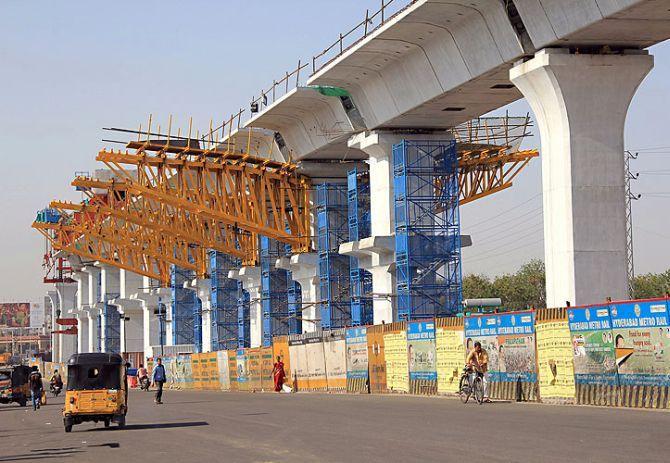 | « Back to article | Print this article |
To spur economic growth and achieve USD 5 trillion economy, India needs to spend about USD 1.4 trillion on infrastructure during FY2020-25, the Economic Survey tabled in Parliament on Friday said.

Investment in infrastructure was necessary for the economy, as power shortages, inadequate transport and poor connectivity affect overall growth performance, as per the Economic Survey 2019-20 tabled in Parliament by Union Finance and Corporate Affairs Minister Nirmala Sitharaman.
"To achieve GDP of USD 5 trillion by 2024-25, India needs to spend about USD 1.4 trillion (Rs 100 lakh crore) over these years on infrastructure so that a lack of infrastructure does not become a constraint to growth.
"NIP is expected to enable well prepared infrastructure projects that will create jobs, improve ease of living and provide equitable access for infrastructure for all, thereby making growth more inclusive," the Survey said.
As per the National Infrastructure Pipeline (NIP), the central government (39 per cent) and state government (39 per cent) are expected to have an equal share of funding of the projects followed by the private sector (22 per cent).
Projects worth Rs 42.7 lakh crore are currently under implementation.
The Economic Survey noted that road transport was the dominant mode of transportation.
In 2017-18 the share of transport sector in the Gross Value Added (GVA) was about 4.77 per cent of which the share of road transport was 3.06 per cent, followed by failways (0.75 per cent), air transport (0.15 per cent) and water transport (0.06 per cent).
Total investment in the roads and highways sector has gone up more than three times in the five-year period of 2014-15 to 2018-19, it said.
The Survey marked that during the year 2018-19, Indian Railways carried 120 crore tonnes of freight and 840 crore passengers, making it the world's largest passenger carrier and the fourth largest freight carrier.
Taking a comprehensive view of civil aviation, the Survey observed that India has 136 airports commercially managed by the Airports Authority of India and six under public private partnerships for operation, maintenance and development of airports.
A total 43 airports have been operationalised since the scheme for operationalising unserved airports was taken up.
To ease the strain on existing airport capacities, 100 more airports are to be made operational by FY 2023-24, the Survey said, adding that to continue with the high growth trajectory the government has been providing a congenial environment so that Indian carriers double their fleet from about 680 aircraft at the close of 2019 to 1200 by FY 2023-24.
About the shipping sector, the Economic Survey stated that around 95 per cent of India's trade by volume and 68 per cent in terms of value was transported by sea. As on September 30, 2019, India had a fleet strength of 1,419 ships.
The major ports in the country have an installed capacity of 1514.09 million tonnes per annum (MTPA) as on March 2019 and handled traffic of 699.09 MT during 2018-19.
The Survey said the ministry of shipping was striving to improve operational efficiencies through mechanisation, digitisation and process simplification. The average turnaround time in 2018 improved to 59.51 hours as against 64.43 hours in 2017-18.
The Survey said universal electrification progress has been made in generation and transmission of electricity. The installed capacity has increased from 3,56,100 MW in March 2019, to 3,64,960 MW as on October 31, 2019.
The Survey underlined that access to electricity was necessary for making growth inclusive and for promoting ease of living.
Pradhan Mantri Sahaj Bijli Har Ghar Yojana (SAUBHAGYA) was launched on September 25, 2017, with an outlay of Rs 16,320 crore to achieve universal household electrification by providing last mile connectivity by March 31, 2019.
The Survey observed that except for a few households in Left Wing Extremism affected Bastar region of Chhattisgarh, all the states have reported electrification of all households on the SAUBHAGYA portal.
On the mining sector it said there has been a notable turnaround in mineral production because of policy reforms, and production of major minerals during the year 2018-19 has recorded a growth of 25 per cent when compared to last year in terms of value.
While giving an overview of the construction sector, which includes housing and employs about 12 per cent of the workforce, the Survey said it accounted for 8.24 per cent of GDP.
The Pradhan Mantri Awaas Yojana-Urban (PMAY-U), launched in June 2015, the Survey said, was one of the largest housing schemes in the world covering the entire urban India and was being implemented through four verticals.
The scheme was moving towards achieving the vision of a "pucca" house to every household by 2020, it said, adding that 32 lakh houses have been completed and delivered.
The Survey noted that since the launch of the Smart City Mission in 100 cities 5,151 projects worth more than Rs 2 lakh crore were at various stages of implementation and added that a total of 1,290 projects worth Rs 22,569 crores have been completed and are operational.
Photograph: Courtesy L&T Metro Rail.